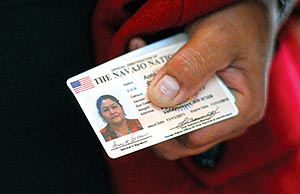First tribal ID cards issued
By Noel Lyn Smith
Navajo Times
WINDOW ROCK, Nov. 17, 2011

(Special to the Times - Donovan Quintero)
Anna Marie Brown from Vanderwagon, N.M., was one of the first Navajo Nation citizens to receive the new ID card Nov. 11 at the Navajo Nation Museum in Window Rock.
Tom Ranger, director of the Division of Human Resources, said they were randomly selected and received their ID cards during the official launch held Nov. 11 at the Navajo Nation Museum.
"I think there was a lot of enthusiasm," Ranger said Tuesday.
The photo ID card is the size of a driver's license, and shows much of the same information - name, birth date, gender, physical characteristics, mailing address, signature and a date of issue and expiration.
But it also lists the person's tribal enrollment number and Navajo officials say it is an acceptable replacement for the federal Certificate of Indian Blood to prove tribal membership.
Each card costs $17 and is valid for four years. If a cardholder is a veteran and would like that status indicated on the card, he or she can submit a copy of their DD-214 form.
The goal is to have each member of the Navajo Nation carrying the cards. Until then the federal Certificate of Indian Blood remains a valid form of tribal enrollment.
There are several security features on the card including a holographic seal of the Navajo Nation and a machine-readable zone, which contains the cardholder's personal information in a format that can be scanned by border agents to cross into Canada and Mexico.
"What we are trying to do is make it where it is very difficult to reproduce fraudulently," Ranger said.
Ranger said he has heard of incidents were individuals have tried to use fake CIBs to enter the United States.
In one incident, a couple tried to enter the country from Mexico but were thwarted because the border agent who questioned the couple was Navajo and grew up in Tuba City. She asked the couple questions about Navajo culture and tried to talk to them in Navajo, which they did not understand.
"She said there have been some instances where people have duplicated the CIB and used that to try to come across because there is no fingerprints, there's no biometrics at all," Ranger said.
He has also heard that the Office of Vital Records, which is under his division, has received calls to verify tribal enrollment from foreign officials.
Two days prior to the kickoff event, the Vital Records staff held a demonstration for President Ben Shelly.
It was then that Shelly, first lady Martha Shelly and Vice President Rex Lee Jim received their cards.
Ranger is also carrying the card.
"I've actually used it," he said. "I flew last week and they took it at the airport."
Deswood Tome, acting public information officer for the president's office, said when Shelly was vice president he was part of an advisory group that met with representatives from the U.S. Department of Health and Human Services to discuss tribal ID cards.
"This is something President Shelly has been passionate about and now it's here," Tome said.
According to information from Vital Records, the idea of developing the card has been in the works for more than 15 years and in 2006 then-Council delegate Larry Anderson (Fort Defiance) sponsored a bill to create a similar program.
The cards will be available to the public by the end of the year. Meanwhile the Vital Records staff will continue training.
Once the program is in full operation, people can apply for their cards at their agency offices.
Ranger said his division is also brainstorming about having a portable unit visit Phoenix, Denver and other cities with large Navajo populations to issue cards.
"It's not finalized but an idea that we might be able to do," he said.
Information: 928-871-6375.

